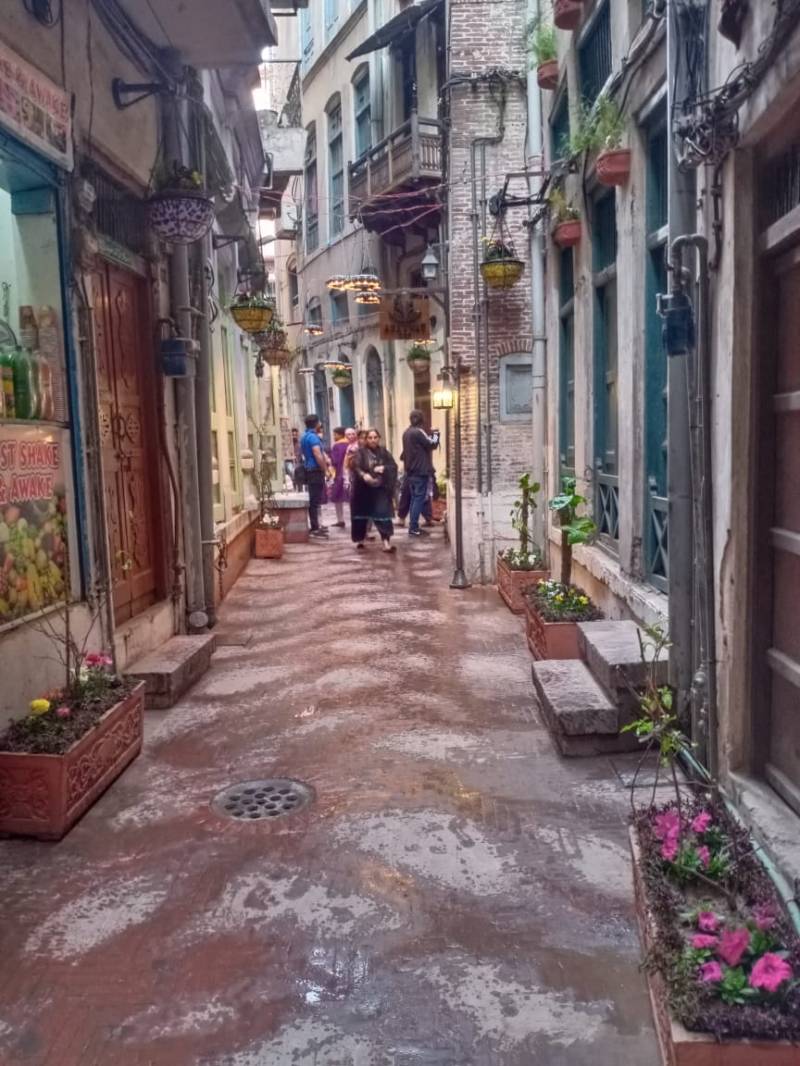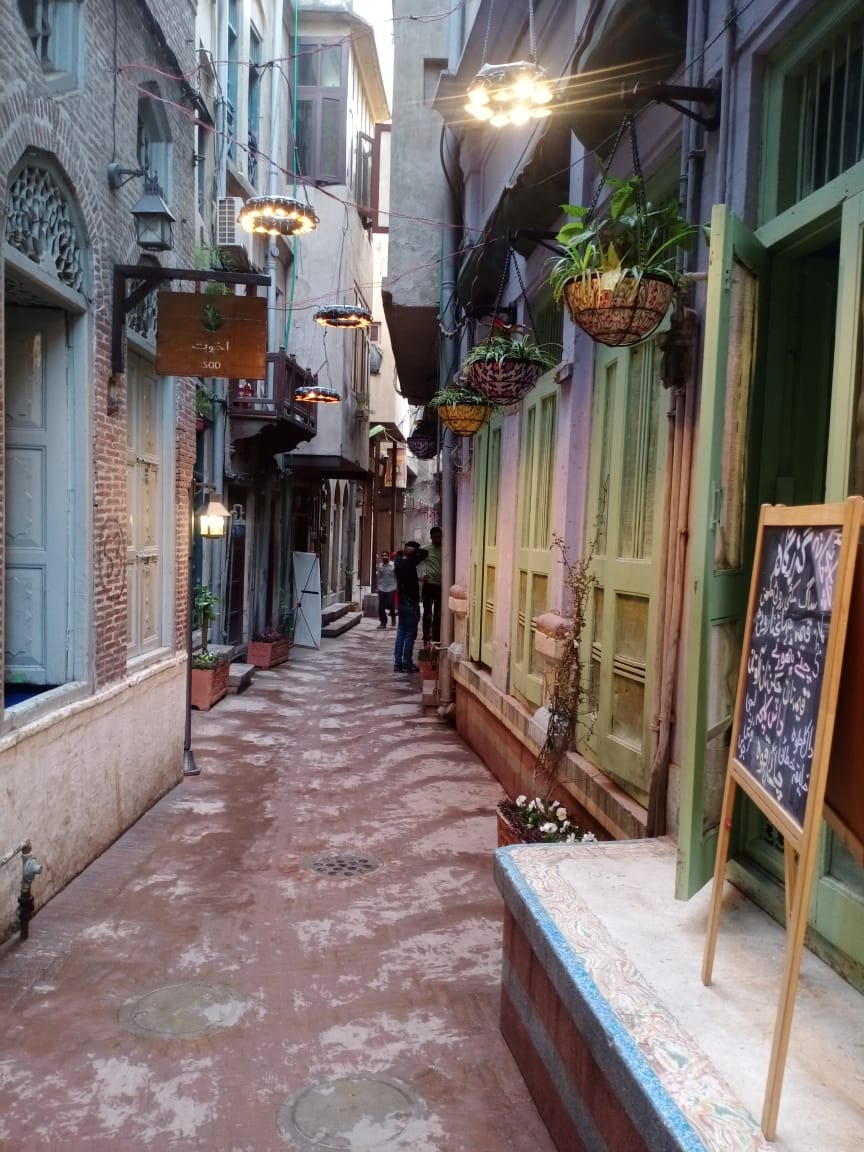
This is not Europe – it’s a street in Lahore”, was the most received comment under the picture of Gali Surjan Singh, once it went viral on the social media in Pakistan. Tourists started hovering in the street to see if it was real or photoshoped because many myths and rumors were in the air. But in fact, the street looked so attractive that it pulled the tourists towards itself and that was the power of one model street designed by the Walled City of Lahore Authority, Aga Khan Culture Service Pakistan and the Akhuwat Foundation.
Now let me take you to this marvelous street located on the Royal Trail in Delhi Gate, Walled City of Lahore. As you enter the gigantic arches of the colonial built Delhi Gate, you will be walking on the Royal Trail, a passage that was used by the Mughals to commute from Delhi to Lahore Fort. Imagine yourself walking on this majestic and royal path. Walk a little ahead and on your right a narrow alley will lead you in the Surjan Singh Street. Well, you can ask anyone around as well for the street and they will guide you as Lahore is a city of love and hospitality and the people there are full of affection and admiration for the tourists.
Initially there are a couple of shops but as you cross them in the narrow street you will come across the beautiful street ‘Gali Surjan Singh’, and you will have to hold on to your breath to grasp the beauty for a while…its mind blowing.
Gali Surjan Singh was named after Hakim Surjan Singh, the 19th century physician who lived in the street. Surjan Singh was a known physician in that era and was respected by the people. He had cured many royals and that is why the street was named after him and because of his popularity, the street was named after him.
As you go further down the street you will see different colorful shops and tea stalls among the hustle and bustle of the residents. What an amazingly vibrant sight!
The built of the street and its architecture is amazing. The most astounding section of this mesmerizing street is the tharas (platforms outside houses) where the residents still sit together for chit chat and socializing, mostly during evenings, once they get free from their morning works and commitments. This thara system was a dense culture in old times and now can only be seen in a few parts of the walled city. This street is lucky that it still has a lot of tharas and you will see the local culture there, even a ghara player will entertain you in this street, who is always sitting on thara and singing different songs.
Inside the street in one of the houses, local children gather and play different musical instruments and entertain the tourists with traditional music, and that takes the tourists into a trance.
There are almost 23 buildings here, 18 of which were constructed in the late 19th or early 20th century and catered to middle income households with limited budgets. These buildings also represent the transformations in technology, architectural expression and typology that were affecting Lahore during the colonial period. No doubt it is an interesting street to visit.
You will see high rise buildings in these streets with pigeons everywhere, the cats playing around and friendly with the residents.
Would you believe that most of the houses in the street are open for the neighbors and they use each others’ lobbies, drawing rooms and washrooms. This street depicts the strong neighborhood system that exists in the walled city of Lahore. This is one reason that why the walled city of Lahore is such a secured place to live in.
Down the street also lives the family of Sheikh Muhammad Jahangir (late). This old four marla house with an exquisite old gate is a welcoming home for any tourist who goes into that street. The house is probably 400 years old and the proud Sheikh Sahib used to sit in the classical wooden window which you will find opened all the time, now his son sits there and welcomes all the tourists.
This street was restored as a model street in 2011 by the Aga Khan Culture Service Pakistan in partnership with the Sustainable Development for Walled City of Lahore Project (which later turned into walled city of Lahore authority) and the funding was by the German Embassy.
Recently, the walled city of Lahore authority, took up the task of revamping the look and feel of the street in partnership with Akhuwat Foundation. An office of the Akhuwat Foundation is also located in the same street who give small loans to the locals there without any commission or markups.
The street was decorated with flower pots, plants and hanging lights and all these elements gave the street a new look that amazingly got viral on social media.
Now this is a must visit street for all the tourists and Lahore lovers, and its true that who hasn’t seen this street is not yet born.
Plan a trip and visit this marvel.
Now let me take you to this marvelous street located on the Royal Trail in Delhi Gate, Walled City of Lahore. As you enter the gigantic arches of the colonial built Delhi Gate, you will be walking on the Royal Trail, a passage that was used by the Mughals to commute from Delhi to Lahore Fort. Imagine yourself walking on this majestic and royal path. Walk a little ahead and on your right a narrow alley will lead you in the Surjan Singh Street. Well, you can ask anyone around as well for the street and they will guide you as Lahore is a city of love and hospitality and the people there are full of affection and admiration for the tourists.
Initially there are a couple of shops but as you cross them in the narrow street you will come across the beautiful street ‘Gali Surjan Singh’, and you will have to hold on to your breath to grasp the beauty for a while…its mind blowing.
Gali Surjan Singh was named after Hakim Surjan Singh, the 19th century physician who lived in the street. Surjan Singh was a known physician in that era and was respected by the people. He had cured many royals and that is why the street was named after him and because of his popularity, the street was named after him.
As you go further down the street you will see different colorful shops and tea stalls among the hustle and bustle of the residents. What an amazingly vibrant sight!
The built of the street and its architecture is amazing. The most astounding section of this mesmerizing street is the tharas (platforms outside houses) where the residents still sit together for chit chat and socializing, mostly during evenings, once they get free from their morning works and commitments. This thara system was a dense culture in old times and now can only be seen in a few parts of the walled city. This street is lucky that it still has a lot of tharas and you will see the local culture there, even a ghara player will entertain you in this street, who is always sitting on thara and singing different songs.
Inside the street in one of the houses, local children gather and play different musical instruments and entertain the tourists with traditional music, and that takes the tourists into a trance.

There are almost 23 buildings here, 18 of which were constructed in the late 19th or early 20th century and catered to middle income households with limited budgets. These buildings also represent the transformations in technology, architectural expression and typology that were affecting Lahore during the colonial period. No doubt it is an interesting street to visit.
You will see high rise buildings in these streets with pigeons everywhere, the cats playing around and friendly with the residents.
Would you believe that most of the houses in the street are open for the neighbors and they use each others’ lobbies, drawing rooms and washrooms. This street depicts the strong neighborhood system that exists in the walled city of Lahore. This is one reason that why the walled city of Lahore is such a secured place to live in.
Down the street also lives the family of Sheikh Muhammad Jahangir (late). This old four marla house with an exquisite old gate is a welcoming home for any tourist who goes into that street. The house is probably 400 years old and the proud Sheikh Sahib used to sit in the classical wooden window which you will find opened all the time, now his son sits there and welcomes all the tourists.
This street was restored as a model street in 2011 by the Aga Khan Culture Service Pakistan in partnership with the Sustainable Development for Walled City of Lahore Project (which later turned into walled city of Lahore authority) and the funding was by the German Embassy.
Recently, the walled city of Lahore authority, took up the task of revamping the look and feel of the street in partnership with Akhuwat Foundation. An office of the Akhuwat Foundation is also located in the same street who give small loans to the locals there without any commission or markups.
The street was decorated with flower pots, plants and hanging lights and all these elements gave the street a new look that amazingly got viral on social media.
Now this is a must visit street for all the tourists and Lahore lovers, and its true that who hasn’t seen this street is not yet born.
Plan a trip and visit this marvel.
